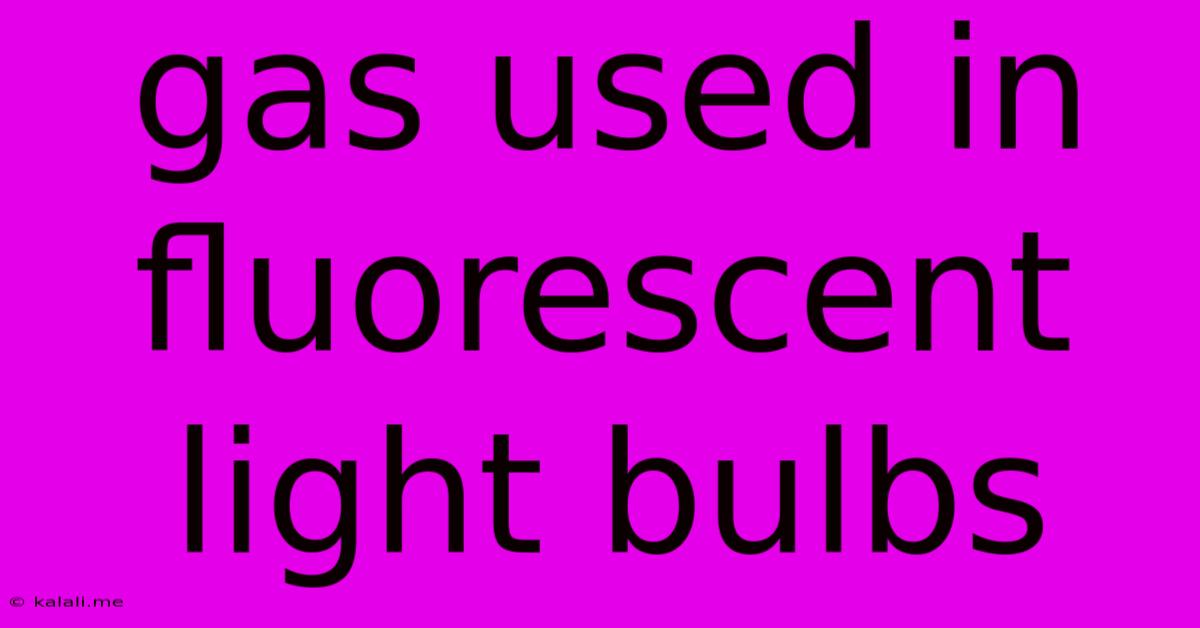Gas Used In Fluorescent Light Bulbs
Kalali
Jun 15, 2025 · 3 min read

Table of Contents
The Gases Inside Fluorescent Light Bulbs: More Than Just Light
Fluorescent lighting, a staple in homes and offices for decades, relies on a fascinating interplay of electricity and gases to produce its characteristic bright, energy-efficient light. But what exactly are those gases, and how do they work? This article delves into the science behind fluorescent lighting, exploring the gases used and their crucial role in the light-producing process. Understanding this will help you appreciate the technology behind this common light source and perhaps even troubleshoot issues with your own fluorescent lights.
The Primary Gas: Mercury Vapor
The core component of a fluorescent lamp is mercury vapor. This isn't pure mercury in its liquid metallic form, but rather mercury in a gaseous state. A small amount of liquid mercury is introduced into the glass tube during manufacturing. When electricity is applied, this mercury vaporizes. The electricity doesn't directly produce visible light; instead, it excites the mercury atoms. These excited atoms then release energy in the form of ultraviolet (UV) radiation. This UV light is invisible to the human eye.
The Role of the Phosphor Coating
This is where the phosphor coating on the inside of the glass tube comes in. This coating is a carefully formulated mixture of various phosphor compounds. When the UV radiation emitted by the mercury vapor strikes the phosphor coating, it causes the phosphor to fluoresce – emitting visible light. The color temperature and overall appearance of the light depend on the specific composition of the phosphor coating. Different phosphors produce different wavelengths of light, allowing manufacturers to create fluorescent lamps with various color renditions, from cool white to warm white.
Inert Gases: Argon and Neon
To facilitate the process, fluorescent bulbs also contain inert gases, primarily argon and sometimes neon. These gases are not directly involved in light production, but they serve a critical function. They act as a buffer gas, helping to maintain the appropriate pressure within the tube and promoting the ionization of mercury vapor when electricity is applied. This ionization is essential for the creation of the electric discharge that excites the mercury atoms. The addition of these inert gases improves the efficiency and longevity of the bulb.
Other Gases: Less Common Additions
While argon is the most common inert gas, other gases might be included in smaller quantities depending on the desired characteristics of the lamp. These are less frequently used and the specific gas composition varies greatly between manufacturers and lamp types.
Understanding the Environmental Impact
It's important to note that due to the presence of mercury, fluorescent bulbs are considered hazardous waste. Proper disposal methods are crucial to prevent environmental contamination. Recycling programs are widely available for fluorescent lamps, and these should be utilized whenever possible. Improper disposal can lead to mercury leaching into the environment, posing a risk to both human health and ecosystems.
Conclusion: A Complex Yet Efficient System
The seemingly simple fluorescent light bulb is actually a sophisticated system reliant on a precise mixture of gases to produce light efficiently. The interaction of mercury vapor, phosphor coating, and inert gases like argon creates a light source that has revolutionized indoor lighting, though it's crucial to remember the environmental responsibility associated with its disposal. Understanding this intricate process allows for a greater appreciation of the technology involved in a ubiquitous household item.
Latest Posts
Latest Posts
-
Difference Between Cellulose Starch And Glycogen
Jun 16, 2025
-
Sample Cover Letter For Visa Application
Jun 16, 2025
-
Case Western Reserve University Average Sat
Jun 16, 2025
-
Which Memory Has Largest Storage Capacity
Jun 16, 2025
-
Where Is Air Pressure The Highest
Jun 16, 2025
Related Post
Thank you for visiting our website which covers about Gas Used In Fluorescent Light Bulbs . We hope the information provided has been useful to you. Feel free to contact us if you have any questions or need further assistance. See you next time and don't miss to bookmark.